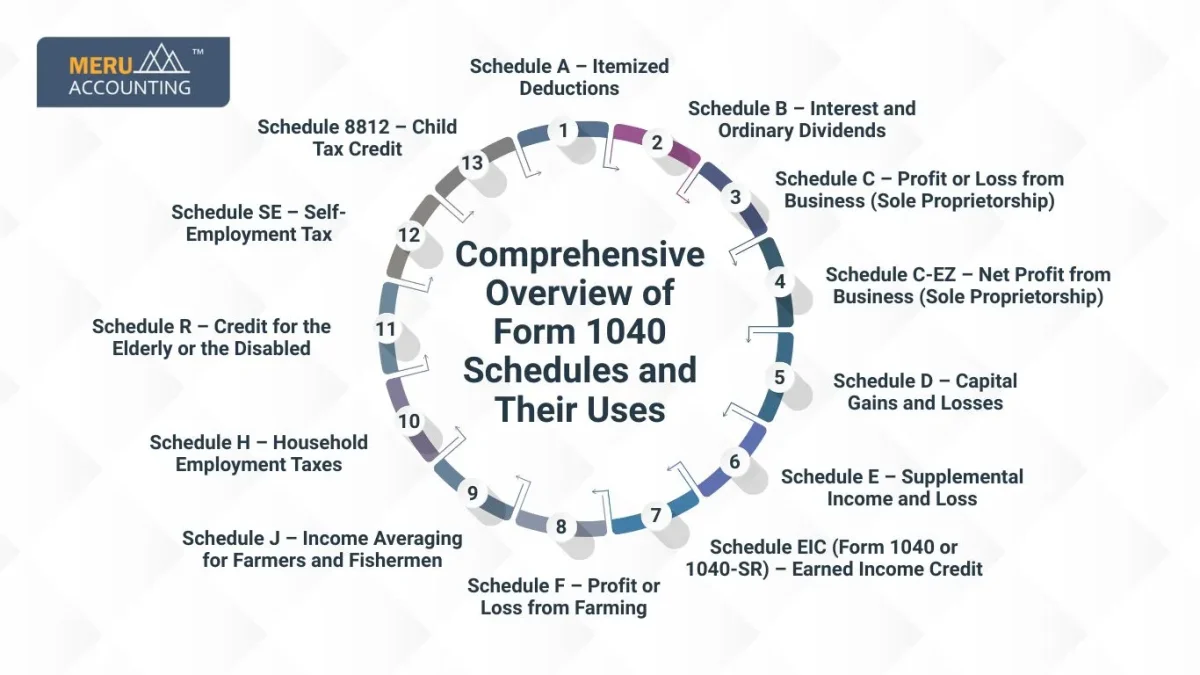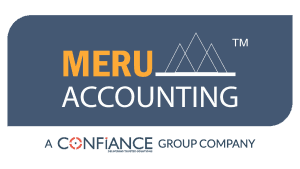Brief explanation of 1040 schedules
Form 1040 is used to file the annual income tax returns by an individual in the USA. This form has various sections that the taxpayers should disclose to calculate their taxable income. The individual taxpayer has to file their taxes with the IRS. Though many people do not need any 1040 schedules and only need to file a 1040. Every person who earns income above a certain threshold needs to pay income tax to the Internal Revenue Service (IRS).
These taxes apply to all the people living in the USA. These people need to keep track of all the income they receive and file the taxes accordingly. Initially, they need to have a proper explanation of various types of Form 1040 schedules and their usage for USA citizens. They have to know all the different 1040 forms and the selection of the best form applicable to them. Many people in the USA are unaware of the categories of the tax payable slab. It is only through a clear explanation of the different 1040 schedules for USA citizens that you can gain the right knowledge of how they work.
Comprehensive Overview of Form 1040 Schedules and Their Uses
Schedule A – Itemized Deductions
Schedule A, a part of Form 1040 schedules, claims all the itemized deductions on the return of taxes. You need to file a Schedule A with your tax returns with Form 1040. Schedule A is applicable when you are doing activities like charitable donations, mortgage interest, and several other expenses. Here, we do tallies of all the itemized deductions properly. This form also mentions the taxes, like state income tax, property tax bills, and sales tax records, in a proper format. The seven major sections of the Schedule A include taxes you pay, dental & medical expenses, payment for the interest, charity or gifts, theft loss & casualty, and several other itemized deductions.
Schedule B – Interest and Ordinary Dividends
Schedule B applies to the individual who receives the dividends, income, or interest for a particular year. We have to make a proper calculation of the tax, which can be reflected correctly on Form 1040. Here, the person who receives income more than $1,500 through dividends and taxable interest has to fill out Schedule B (Form 1040) for the IRS. Here, we have to mention the name of each payer along with the amount they have to pay in the form. It becomes much more difficult to file Schedule B to categorize the tax in this section, so using suitable software can be a wise idea to make things proper here.
Schedule C – Profit or Loss from Business (Sole Proprietorship)
Schedule C is a very vital tax form that is very important for small and medium-scale business owners which particularly has a Sole Proprietorship. Law firms also fill out this form.
- Single-member limited liability companies (LLCs) [elected to pay tax, not a corporation or S corporation]
- Qualified Joint Ventures
Schedule C also applies to individuals who are freelancers, contractors working independently, any side income work, or operating a business on their own. Here, the individual is responsible for all the profits, losses, and liabilities.
Schedule C-EZ – Net Profit from Business (Sole Proprietorship)
All small businesses should use Schedule C when calculating taxes for the business. Here, the business expenses, income, and net income of the business have to be mentioned.
There are five parts in Schedule C.
- Part I – Listing the income and the gross profit earned
- Part II – Calculating the net loss or net profit by subtracting all the expenses from the income
- Parts III, IV & V – Here, the businesses are included that have inventory for the purchase, claim deductions for the vehicle expenses, and any other expenses that are not mentioned in Part II
Schedule D – Capital Gains and Losses
Schedule D of the “Form 1040” mentions the taxes applicable to capital gains and losses. Here, you have to mention the sale of the capital assets and everything you use or own for pleasure. You can report here on the capital assets like bonds, stocks, and the homes you sell. The calculations made on Schedule D, part of the 1040 schedules, will align with the individual tax return. Here, Schedule D is provided to help taxpayers provisionally report their losses and gains and associated taxes. The assets or investments that are sold have to be recorded for tax. Generally, we categorize capital gains or losses on a short-term or long-term basis.
Schedule E – Supplemental Income and Loss
Schedule E taxes apply to the taxes applicable for specific types of income, which are under the supplemental. The business listed under Supplemental Income or Loss includes things like royalty income, real estate income, partnerships, estates, S corporations, REMICs, and trusts. These types of income get special tax treatment as per IRS rules. You need a very expert tax consultant while filing the tax returns under this category.

Schedule EIC (Form 1040 or 1040-SR) – Earned Income Credit
This section is particularly for the people who fall under the lower-income taxpayer category. This is a specialized tax credit granted, which is also called EIC or Earned Income Credit. They have at least some earnings during a particular year. To qualify to pay this kind of tax, you need to work for someone or own a business. You can even own a farm to qualify for the basic rules that apply for the EIC.
Schedule F – Profit or Loss from Farming
Schedule F is used to report the income tax from agricultural or farming activity. Regardless of the primary business activity you do, it applies to all the income earned through farming. Here, one can enjoy the tax deductions and other farming-related credits the government offers.
Schedule H – Household Employment Taxes
Schedule H of the household employment tax is paid for the individuals who are involved in the household-related activities. The household employees, when paid wages, which can be in cash subject to Medicare, Social Security, or FUTA taxes. These people can also be electricians, plumbers, babysitters, or any other person whom you hire some while on an occasional basis. If you pay the taxes to the Internal Revenue Service, then you have to calculate a precise amount along with the portion you owe.
Schedule J – Income Averaging for Farmers and Fishermen
Schedule J (Form 1040) of the income tax applies to people involved in occupations like fishing and farming. Here, the tax applicable is significantly lower when compared with the other slabs of the income tax. We calculate the base income regarding the income that they earn in the last three consecutive years. Here, we can exclude some incomes, like selling or buying animals or plants. Also, the ingredients taken for activities like horticulture receive some kind of exemption.
Schedule R – Credit for the Elderly or the Disabled
Under Schedule R, a certain amount of credit applies for the category of persons who are above 65 years of age. Also, the person having a disability applies under this category. The process of calculations is very simple for the people under these categories. Just by having all the details of the income from different sources, the tax calculations will be much simpler. The people under this category can enjoy a nice credit on their taxes and deductions, which can minimize their taxes.
Schedule SE – Self-Employment Tax
Schedule SE tax applies to people who are self-employed, and they can even be small business owners. Based on their incomes, these people have to pay their taxes accordingly. The taxes here are collected mainly for Medicare taxes and Social Security benefits. An expert tax consultant can wisely bring down your taxes paid in a much simpler way in this category.
Schedule 8812 – Child Tax Credit
This schedule is applicable to any of the children who qualify for the USA resident criteria that come under this category. The child tax credit is refundable if it exceeds the tax liability.
These are short descriptions of all the Form 1040 schedules, shedding light on the taxes applicable for US citizens under each category. The above explanation on the different 1040 schedules for USA citizens broadly outlines the tax slabs in the USA and the several schedules that are also categorized under it. Before missing out on some exclusive savings, read all the brief explanations on the 1040 schedules properly.
Tips for Handling 1040 Schedules
1. Know Your Income Types
Before you start, list your income types:
- Wages
- Side gigs/freelance work
- Dividends or capital gains
- Rent
- Unemployment
Each type might need a different 1040 schedule:
- Got rent income? Use Schedule E
- Got side gig income? Use Schedule C
If you miss income, the IRS may charge you extra tax and a fine.
2. Look for Credits and Deductions
Tax credits and deductions help cut your tax bill. If you itemize, use Schedule A. Some key credits include:
- Child Tax Credit
- Earned Income Credit (EIC)
- American Opportunity or Lifetime Learning Credit
- Health Coverage Tax Credit
These credits may need a special form or Form 1040 schedule.
3. Use Tax Software or a Pro
Even with simple taxes, errors can happen. A good tax tool will:
- Pick the right schedules for you
- Add them in the right order
- Catch math or entry mistakes
If your return has things like rental homes or foreign income, it’s smart to get a tax pro. It can save time and worry.
4. Double-Check Everything
Before you send in your return:
- Make sure all totals are right
- Check that each schedule is there
- Put your name and SSN on each page
- Keep a full copy for your files
Errors can slow your refund or cause an audit.
Meru Accounting is a very prominent company providing bookkeeping and other accounting services for the USA and other parts of the world. We ensure better tax compliance by helping clients understand and use the Form 1040 schedules correctly. Our team stays updated with IRS rules to avoid filing errors. We help individuals and firms reduce tax risks and manage records well. With expert support, we simplify complex forms and ensure timely filing.
FAQs
- Do I need to file all 1040 schedules?
No, only file the ones that apply to your tax situation. - What is the most used 1040 schedule?
Schedule A and Schedule C are among the most commonly used. - Can I file 1040 schedules online?
Yes, most e-filing systems support all 1040 schedules. - What if I forget a schedule?
You may need to amend your return using Form 1040-X. - Do tax software tools include 1040 schedules?
Yes, they usually auto-include needed schedules. - Are 1040 schedules the same every year?
No, the IRS may update or change them yearly. - How do I know which 1040 schedule to use?
Check your income and deductions; tax tools or professionals can guide you.








